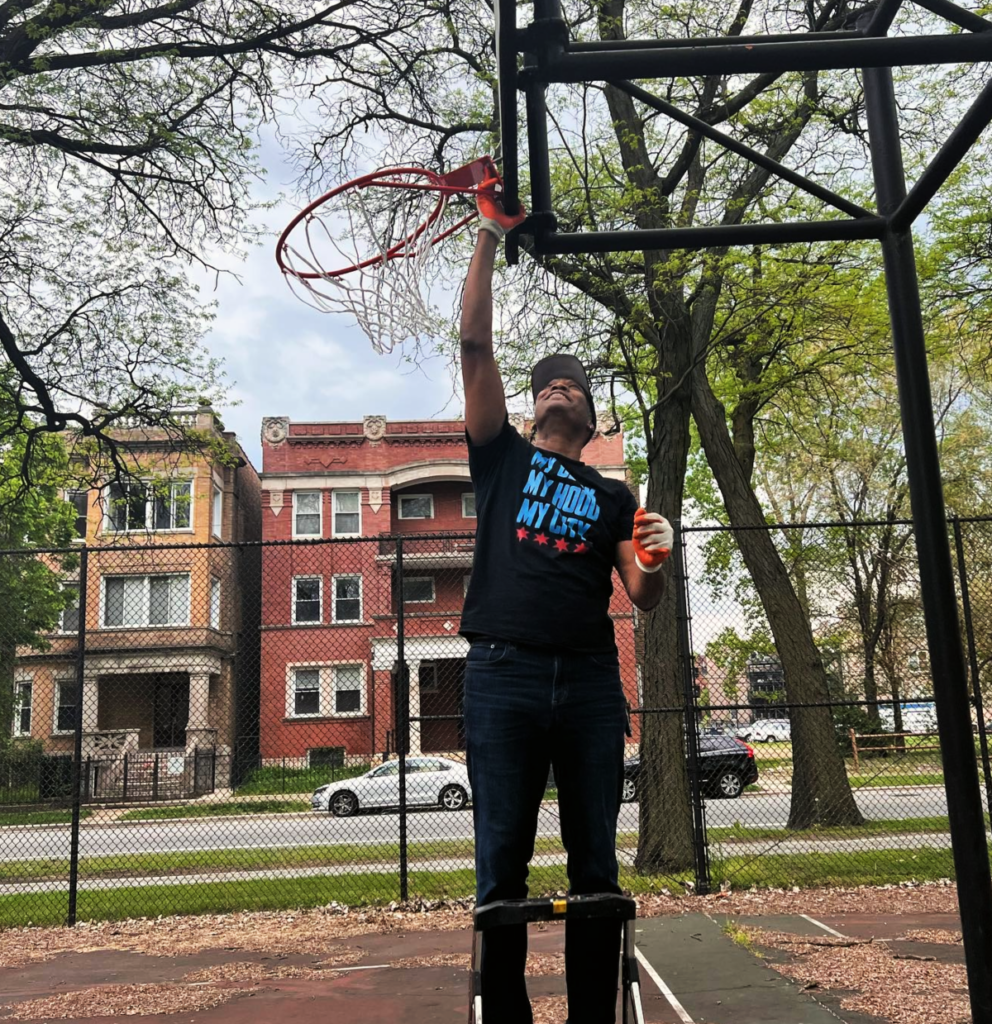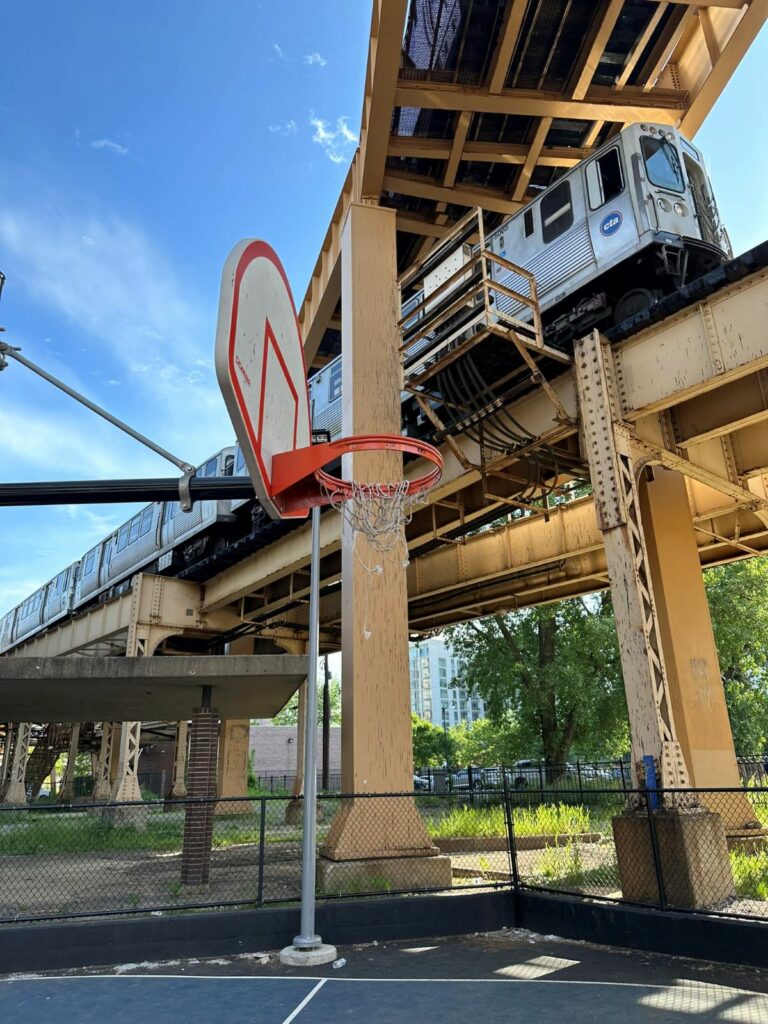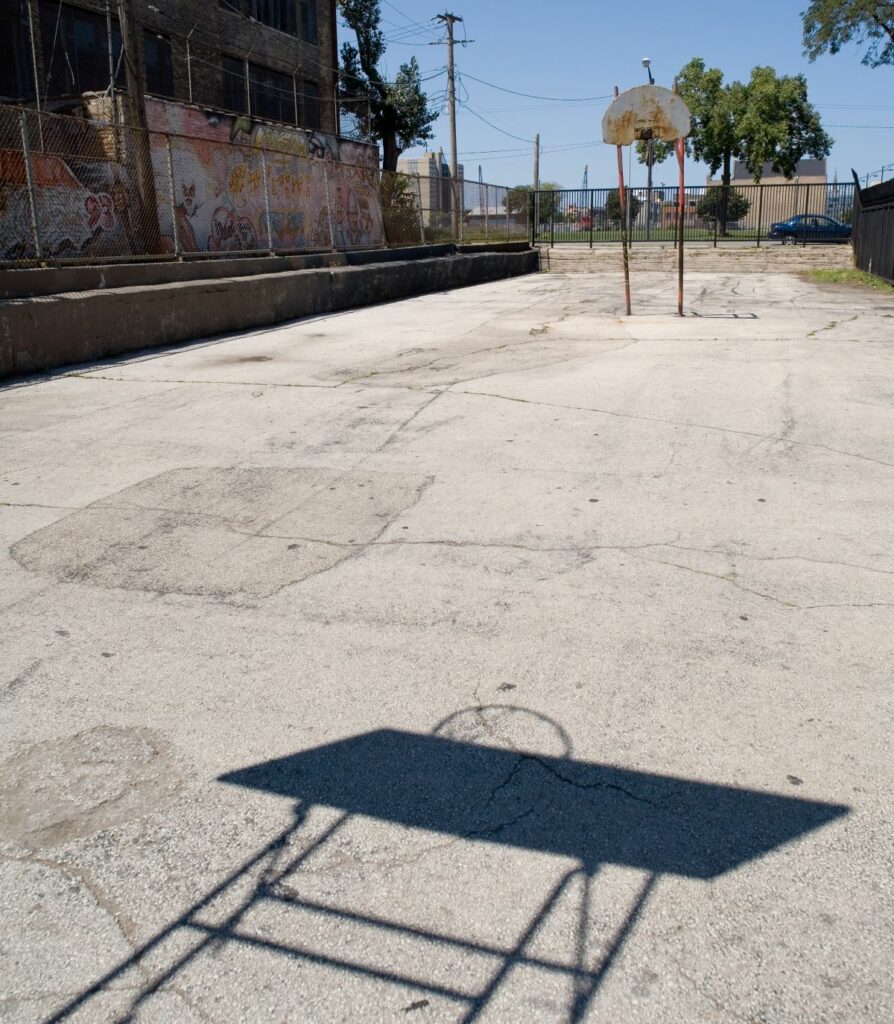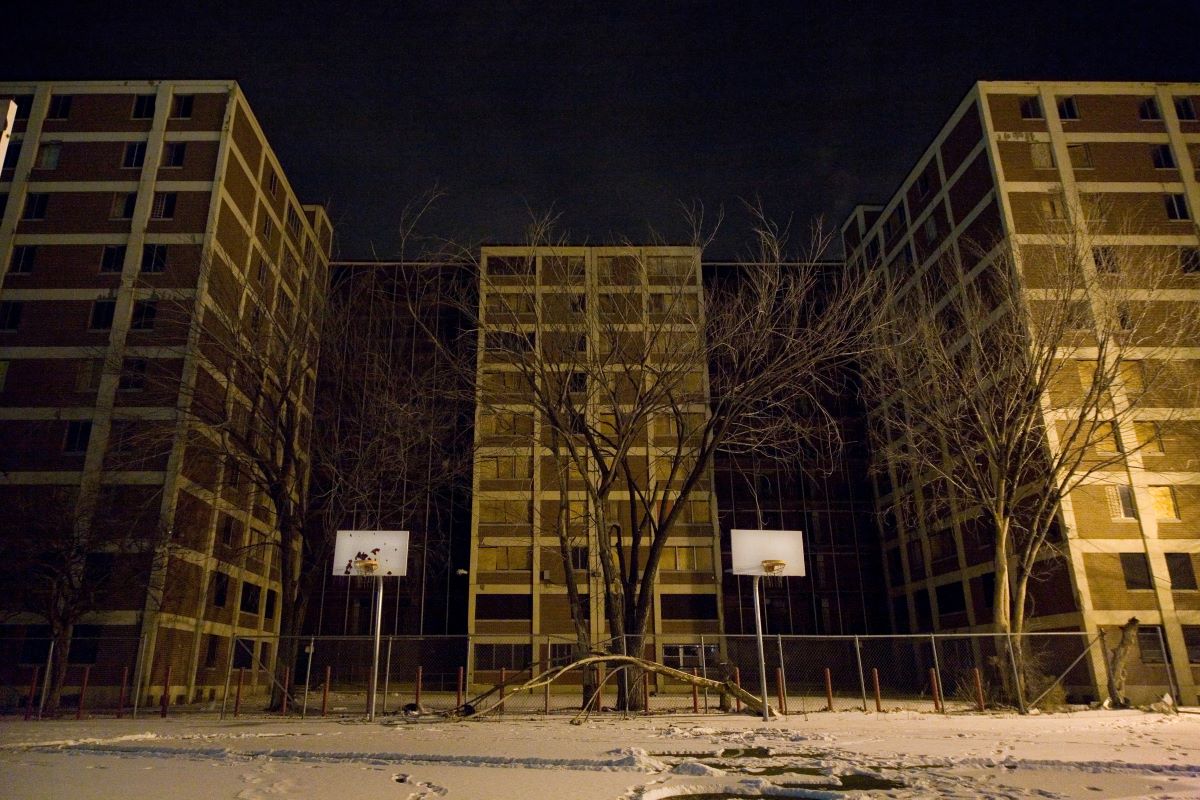On May 7, Jahmal Cole of My Block, My Hood, My City pulled up to the court at the National Teachers Academy (NTA) on the Near South Side hoping to join a pick-up basketball game, but he found the school’s pristine backboards without hoops or nets, and no other players in sight. Hoopers are resilient, but you can’t ball without a rim. Fed up with what had become an all-too-familiar scene, Cole posted a photo of the empty court on his organization’s Facebook page. “Come on man,” he wrote in a caption, “I came all the way over here to hoop and the rims are gone.” An avid pick-up player, Cole sees the disappearance of rims as part of a broader trend.
There was never a mayoral decree or an aldermanic commission that declared war on streetball, but over the past several decades, the intensely local networks and public infrastructure undergirding the game have come under assault. From homeowners who wanted to keep Black and working-class youth from congregating in their neighborhoods to the destruction of public housing complexes’ outdoor courts as well as their communities of players and the accumulated neglect of public courts, the game has sustained blows from multiple directions. Yet the throughline—in basketball becoming victim to a dissolving social fabric and associated with disorder following the tough-on-crime era—is anti-Blackness and shifting ideas about the right to the city.
Then COVID-19 brought a major shock to an already fragile system, as the Chicago Park District initially removed 647 of the city’s 771 rims from courts during the initial pandemic lockdown. Even as the Park District slowly began reinstallation, the episode brought new attention to the ongoing neglect of public courts. A 2020 article in the Chicago Reader highlighted “disappearing hoops in gentrifying neighborhoods,” but for those involved in the street game, the worst of the damage had been done years before the pandemic. “Where have all the hoops gone?” asked a July 2000 investigation in the Chicago Tribune, tracing what was already by then a pronounced trend across the city.
The disappearance of rims has consequences for the game and for the community. Cole believes pick-up games pose a valuable opportunity for “us older guys to come to the hood and subtly mentor the youth,” but without basic infrastructure, these social opportunities are foreclosed. In the days following his thwarted attempt to play at the NTA, Cole announced a campaign to “Save Streetball” by installing missing nets at courts across the city. He created an online form for Chicagoans to report local courts in need of repair. In the first week of the project, Cole acquired twenty-five Wilson nets and headed to Altgeld Gardens, where he scaled a ladder to hang them from empty rims. This act—an inversion of the ritual in which victorious hoopers cut down the net following a championship—was a gesture of tactical urbanism, a cheap, rogue intervention to install a vital resource that formal channels failed to provide.
Repairing Chicago’s neglected streetball infrastructure requires buy-in and support far beyond the initial twenty-five nets. But these initial gestures—hanging nets and photographing courts in need of more serious repair—thrust the status of streetball into the public eye. As Cole’s campaign was covered by virtually every outlet in Chicago, “people started scrambling because they realized how much of an issue it was,” he said. “Even the park district said they started putting more rims back up because we made an issue out of it.”

In addition to replacing hoops still missing from the pandemic or removed due to prior complaints, Cole is working to raise $100,000 to fully renovate twenty-three outdoor courts and is in talks with the Chicago Park District and a range of potential partners. Though formal partnerships have not been finalized, VP of community engagement for the Bulls, Adrienne Scherenzel-Curry, shared that the organization is “very excited about this initiative.”
Carly Ebisuya, a spokesperson for the Chicago Sky, echoed the team’s enthusiasm for the project, noting that streetball is both “ingrained in Chicago’s broader sports culture,” and “ingrained in our players’ backgrounds.” Ebisuya said that most of the team’s players—including former Sky star Candace Parker, who grew up in Naperville—honed their skill in pick-up games.
Fundamentally, Cole believes that streetball is good for basketball and good for Chicago. “Kids need safe things to do in summer,” he said. “They need free things to do—you might not be able to afford to go to the YMCA, you might not be able to afford AAU, you might not be able to afford to get on the bus to go downtown to do something. Those local parks are necessary, especially to build community.” Streetball’s advocates note that it’s also a potential response to national public health concerns about the detrimental effects of loneliness and isolation, as well as the ongoing promotion of healthy recreational outlets.
Given pronouncements like these, saving streetball seems like something everyone can feel good about. There are always hopes placed on streetball that the game on its own can provide opportunities for personal development or even a haven from violence. And while participants and fans have testified to its power, to really put basketball back in urban space, the city will have to confront larger issues of race, economics, and democracy.
Chicago is a world-class basketball town. We have two professional teams: the Bulls, who have come to represent the city as much as the skyline, and the 2021 WNBA Championship-winning Chicago Sky, the second-most valuable franchise in the league. We’ve watched generations of Chicagoans—from Isiah Thomas and Antoine Walker to Derrick Rose and Jabari Parker—chase their hoop dreams on the national stage. We launched the political career of Barack Obama, America’s basketball president, whose election day games at the East Bank Club and regular White House scrimmages allowed the world’s most powerful man to accrue vital political cool and authenticity.
But Chicago is also a basketball town in another sense. The urban fabric of the city has sustained a vibrant amateur game for decades—streetball. Basketball has been played in parks, streets, and alleyways for almost as long as the indoor game has existed, but streetball is a distinct basketball culture that emerged in US cities after the Second World War. The blacktop is where basketball became Black. Like the contemporary beboppers who pushed the limits of jazz with their adventurous improvisation, streetballers originated new, flashy moves—crossovers, dunks, spins—that reshaped what it meant to play the game of basketball. In its various arrangements, which include three-on-three, twenty-one, and thirty-two, streetball pushes the boundaries of teamwork and individual skill, as hoopers hustle to create their own shots.
But as State Representative Kam Buckner pointed out in a Tribune editorial this spring, the ongoing disinvestment of public basketball courts reflects entrenched policy and “a disturbing history of shutting young people out of public spaces, from removing basketball rims and backboards from parks to downtown curfews.” When it comes to the retrenchment of streetball, the Chicago Park District and its facilities have been a focal point of recent criticism: agency records obtained through a Freedom of Information Act request show twenty courts designated as “inactive.” Of the nearly eight hundred hoops and rims in Park District inventory, however, “active” status does not necessarily reflect equipment that is in working order—it just means the equipment is supposed to be there.
According to Cole, members of My Block, My Hood, My City canvassed one hundred parks around the city and identified more than fifty courts in need of serious repair. This indicates that a substantial number of facilities reported by the Park District as “active” actually lack basic functionality. But the Park District’s facilities are only one piece of the puzzle.

So what happened to streetball? While there was never an official decree calling for its eradication, it’s clear that the public turned on the game as its supporting infrastructure fractured and as public investment in schools and parks dried up. It’s widely recognized that the destruction of Chicago’s high-rise public housing complexes dispersed tight-knit communities and fractured their traditions, such as long-running playground games and tournaments. Many public basketball courts were demolished alongside the housing that sustained them.
The dismal conditions of the playground courts at Chicago Public Schools, where many hoops have been removed or are only available during school hours, reflect changing ideas about the public sphere, and specifically who has the right to public space in the city. A spokesperson from Chicago Public Schools confirmed that there is no district-wide policy governing the availability of playground equipment, including basketball courts: decisions are left up to individual school principals. School playgrounds are typically open to the public, though many are closed from 9:30pm to 6am.
“Some District basketball courts have permanent basket stanchions with portable rims that are installed during the school day for student use and are taken down at the close of the school day,” said the CPS spokesperson. This leads to confusion about the status of neighborhood courts. Many Hyde Parkers consider the playground court at Ray Elementary School as one of the neighborhood’s lost blacktops. Indeed, the hoops are not up, but principal Gayle Neely disagrees with the characterization that the court has been demolished.
“Please note our basketball hoops are not missing,” she said, explaining that they are uninstalled for “school liability purposes” when classes are out of session. The use of “liability” in this case gestures at the law as an immovable external force, but in the case of playground basketball policy, it reflects less a specific legal vulnerability on the part of the school and more of a general notion that basketball creates problems.
Streetball has always depended on the conditions of “the streets.” In the under-resourced neighborhoods where it became popular, the game benefited from its low barrier to entry. Neighborhood parks sustained regular pick-up scenes, where players could easily join in even if they didn’t personally own a ball. Hoopers have historically developed their skills in their own communities, and in the second half of the twentieth century, it wasn’t hard to find a place to practice.
In fact, state investments in urban infrastructure generated the very conditions for a flourishing streetball scene. School playgrounds, neighborhood parks—which employed playground monitors who could provide coaching and instruction—and public housing complexes, which often had both outdoor courts and a critical density of players looking for something to do. Beyond these formal venues, dedicated streetballers made their mark on the city’s landscape, affixing backboards to utility poles and fashioning DIY alley baskets out of crates and other urban refuse.
These local games were linked together through a larger network of competition. South Sider Torrance Smith learned the game on the Fernwood Park blacktop in the 1980s. “Every now and then, you might get some people from the outside to come play,” he said, but most games were played with the same group of “guys from the neighborhood that would come to the park every day.”
Robert Reed, who began playing in the 1970s at Bronzeville’s Madden Park near the then-enormous Madden-Wells-Darrow public housing complex, became a playground coach, helping the neighborhood regulars grow into formidable players. Arne Duncan, who grew up in Hyde Park and played professionally in Australia before serving as chief executive of Chicago Public Schools and secretary of education under President Obama, spent “hundreds of hours” practicing on courts at local schools: Bret Harte, Ray School, Murray, Shoesmith, Shakespeare, and Kenwood High School.
When it comes to streetball, Chicago’s hoopers’ hallowed grounds are a map of Black urbanism: the blacktop of Washington Park, the cages at Jackson Park, Cole Park in Chatham. After pushing the limits of competition with siblings and neighborhood kids, serious players traversed the city in search of new competitors and harder, better ball games. Friendships and rivalries were formed across neighborhood boundaries, often by people who only knew one another by their street names. Even so, Duncan said they were “guys I’d trust my life to, to get me in and out of neighborhoods.” He wanted to go where they could take him, because as he said, “the ball’s on the South and West Sides, so that’s where you go.”
Duncan experienced what Smith calls the “hooper’s pass,” or the idea that basketball players would always protect and assist one as they navigated gang lines and the cartographies of urban violence “As a ball player, you got a pass,” said Smith.
In this era, Chicago’s streetball culture gained recognition, and community leaders took note of its popularity and potential. The city’s broader civic infrastructure underwrote a series of tournaments, such as the Youth-Vision-Integrity (YVI) summer tournament in Hyde Park. The highly visible tournament, which was founded in 1977 and ran for two decades, was originally held at Murray School and then relocated to the outdoor courts at Kenwood Academy, just a stone’s throw from the 6 and 28 bus stop at 51st and Lake Park Avenue. The tournament was a response to crowding on Hyde Park’s playground courts, which were packed daily in the summer by players of different levels. After establishing interest from the players, tournament organizers worked with the 4th and 5th ward aldermen, parents, and local businesses to secure space and funding for things like T-shirts and tournament prizes.
It was a strong contrast to how the top levels of youth basketball operate today, where athletes develop skills through specialized, resource-intensive, pre-professional training programs. “These kids are paying a lot of money,” said Reed. “To play in one of these leagues, [there are] uniform costs, travel expenses, all kinds of things that poor kids from the neighborhood can’t afford.”
Getting good at basketball was something that used to be done in public, and was robustly supported by public infrastructure: playground courts and playground coaches, and community tournaments where the power of the game touched not just the players but intergenerational crowds of spectators and fans. Now elite basketball development takes place privately behind closed doors.
For Chicago’s young basketball fanatics back then, though, the opportunity to watch and interact with top players was more exciting than college or pro sports on television. “Michael Jordan was doing numbers at North Carolina, Patrick Ewing at Georgetown,” said Michael Nance, who attended the tournament while growing up in Hyde Park, but “David Howell was playing at the YVI, and I was going to watch him play because he was tangible to me. I could touch him.”
Over the tournament’s twenty-year run, it hosted legions of talented hoopers including Tim Hardaway, Marcus Liberty, Nick Anderson, Sonny Parker (father of Jabari), Tony McCoy, and Benji Wilson, the top-rated player in the country from Simeon Career Academy. To widespread shock and dismay, however, Wilson was shot and killed in 1984 on the eve of his senior season. While the shooting was unrelated to streetball, his death rocked the local basketball community. The YVI tournament was dedicated to Wilson’s memory in subsequent years, and a sportsmanship award was named in his honor.
Wilson was in many ways a streetball icon. By the time he was in seventh grade, he would travel more than forty blocks by bus to play at Madden Park on Coach Reed’s playground team. At the time, “nobody knew Benji,” said Reed, who often invited Wilson over for dinner and felt a familial bond with the young player. Within a few years, Wilson grew in height as well as in stature. He was the first player from Illinois to be ranked number one in a national college basketball recruiting class.
His death at the hand of another young Black man showed the limits of the “hooper’s pass” and tracked with what many consider to be a turning point in the structure and rhythms of Chicago’s street gangs and gun violence. Many describe it as a “loss of innocence” and a critical factor in local streetball’s demise. Wilson’s tragic “what-if” story became a cautionary tale for generations of Simeon players; serious ballers moved their games indoors and traded public streetball for privately organized leagues like AAU.
Derrick Rose, who wore number twenty-five in honor of Wilson during his Simeon career and more recently in the NBA, avoided streetball growing up out of fear for his own safety. Jabari Parker, another generational Simeon talent, honed his shot in the gym at Hyde Park’s Mormon temple instead of on the local blacktop.
For more casual players, the playground has changed. “They don’t have that sense of safety, and the community is not there,” said Reed. Jobs for playground supervisors and coaches like Reed have dwindled under the same austerity regime that neglected the courts.
Duncan has seen the change too: “Where you could have forty guys out there playing, fifty guys, the courts are basically empty,” he said. “No one feels safe because of gun violence.” After leaving Washington in 2016, Duncan returned to his hometown to cofound Chicago CRED, an integrative anti-violence organization working to reduce gun violence on the South and West Sides.
Somewhere along the way, basketball became a code word for Black urban crime, and the infrastructure that sustained it came under threat. In Chicago, there was a particularly cruel irony to the timing. As the Bulls were becoming one of the most dominant professional basketball teams in the history of the game, public courts around the city were increasingly targeted by community members as a source of social problems.
At the same time, the game was hailed as a promising anti-violence strategy, as evidenced by the Chicago Housing Authority’s short-lived “Midnight Basketball” league, which received support from George H.W. Bush’s “thousand points of light” initiative until it fell victim to mounting bipartisan anti-Blackness. A beloved anti-violence tournament at the Stateway Gardens housing complex abruptly ended in 2001 following a massive police raid, in which players and spectators of all ages were blocked inside the fieldhouse and invasively frisked. (Residents eventually won a settlement for the violation of their civil rights.)
Basketball occupied a contradictory position in the civic imagination: the Bulls’ game was a source of pride and an elite status symbol, the supervised housing project games were a vexed but potentially effective vehicle for economic advancement and violence disruption, but the informal street game—played most vigorously by Black men—became a euphemism for trouble.

“There’s no research showing a connection between basketball courts and an increase in gun violence,” said Roseanna Ander, who leads violence prevention research initiatives within the University of Chicago’s Urban Labs network. Empirical studies back up the game’s anti-gang and pro-social potential, but basketball became a political pawn. Even Duncan, part of those networks as much as anyone, has a deep sense of classic streetball as a safe space, but from a sadly lost age. “I definitely don’t think the city is safer today because those courts are down,” he said. “If someone wants to prove me wrong, I’m happy to listen, but intuitively it just makes no sense whatsoever.”
“I can say that there were things that happened, but I never, ever, ever saw a gun out on those courts,” he added.
From Ander’s perspective, the issue raises questions about urban governance. “What is the motivation if there isn’t good evidence to support taking away a resource from a community that’s already struggling with a lack of access to positive opportunities?” she asks. As Ben Joravsky detailed in a series of articles for the Chicago Reader in 1990 about the conflict surrounding the Shoesmith Park court in Kenwood, homeowners portrayed local streetball players as “foul-mouthed and rude,” and contended that the courts attracted “boom-box-playing thugs and dope dealers who litter the park with glass, trash, and other debris.”
That sentiment tracked with attitudes of many homeowners across the city, who registered their complaints about basketball courts in racially coded innuendo about noise, loitering, litter, and the potential for violence. When access is controlled by individual school administrators, it’s easy to imagine how courts fall in response to the complaints of “not-in-my-backyard” neighbors. The Shoesmith court came down. The Kenwood court, where YVI was played, became a parking lot. A 2000 investigation in the Tribune traced the disappearance of five basketball courts in the 19th Ward, including one that had been recently renovated on the Bulls’ dime, a thin guise for deterring Black youth from playing in the majority-white neighborhood.
As Chicago’s landscape continues to transform, public courts continue to be pushed to the periphery. In fact, there’s nowhere to play basketball downtown, save for the East Bank Club (a private facility with a $235 monthly fee for adults over age twenty-five), which says something about how our city has treated the sport from which we derive so much pride.
The construction of Millennium Park notably began in 1998—the year the Bulls won their second three-peat—yet the crown-jewel park lacks a single basketball court. The Obama Presidential Center, which is currently under construction in Jackson Park despite concerns from residents over displacement, received a $5 million commitment from Nike to fund the construction of athletic facilities. “It wouldn’t be the Obama Presidential Center without a place to shoot some hoops,” the OPC website declares, but a spokesperson for the development declined to provide additional information about the courts and the terms of their future availability.
Every now and then, a new court opens up. In 2021, an innovative outdoor court and community space opened on the West Side following a partnership between the Austin Special Service Area, Invest South/West, and the Chicago Architecture Biennial. While high-profile court developments here and there will not undo the damage caused by decades of neglect, the inclusion of basketball signals a shift in policy that Mayor Brandon Johnson’s administration could expand on.
Recently, I noticed that two sets of hoops and rims were back up at Kozminski Elementary School after a several-year absence. I’m hardly a baller, but the playground is around the corner from my place, so I’ve started visiting to practice my shot. Walking around the neighborhood in possession of a basketball has opened a whole new register of social interaction. One of my first days out, a man asked me to pass him the ball, and when I feebly bounced it to him, he said, “That was garbage!” He was right.
Another time, a group of school-age kids cheered from the other side of the fence when I finally made a jump shot after many misses. During a game of two on two with some friends on Juneteenth, a passing motorist shouted, “White dudes can’t play basketball.” My favorite came as I walked home one evening: a mom leaned over to her young daughter, pointed to the ball in my hand, and said, “See, I told you girls play basketball.”
There’s been a trickle of activity at the court. Most of the time, it’s just one person or small groups of two or three players. One afternoon, my friends and I shared the court with Dhane, a student at Kenwood Academy, who was also happy to be back on our local blacktop. “I think it’s good for the kids because they’ve got another thing to do,” he said. “I used to come here a lot when the rims were up, but I don’t come here no more. This is my first time back.”
“There’s a common belief that if you take those rims down, that it will improve the safety of the community, and it’s not fair,” said Cole. “Parks belong to everybody.” This is true, and even more: the city itself belongs to everybody.
Kit Ginzky is a Hyde Parker and a PhD candidate in history and social work at the University of Chicago.

